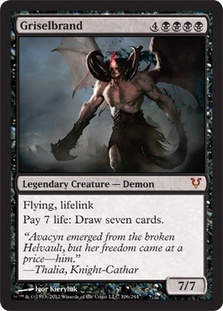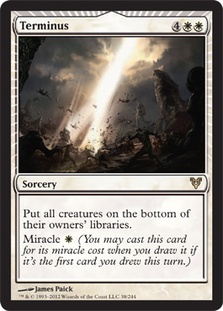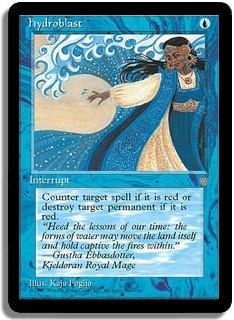I learned a hard but valuable lesson last week: don’t use outdated information to make Magic decisions.
I entered Grand Prix Anaheim with a W/U/R Control deck which had impressed and excited me at Pro Tour Avacyn Restored two weeks before. I expected the deck to be perfect for the Grand Prix field, and I felt more confident than ever going into the tournament. What do you suppose happened to me at Grand Prix Anaheim?
Well, as so often happens, I got exactly what I deserved. I went 3-0 (6-0) against the archetypes that had existed when I put in my hours and hours of testing for the Pro Tour. I went 0-3 against the decks that had broken out—Bant Spirits and Angel of Glory’s Rise Reanimator—in the time since. What made this a particularly painful lesson was how much a very small amount of testing in these matchups could have helped me correct my weaknesses.
With Grand Prix Atlanta and the StarCityGames.com Invitational in Indianapolis on the horizon, my goal is to make sure that my beloved readers and I do not repeat this mistake. In Legacy, like nowhere else in MTG, there exists a tragic combination of danger in using and the temptation to use outdated information.
Legacy has been a slowly evolving format. After all, some things have still not changed since I played my first Legacy (Type 1.5) tournament back in 2005. The best strategies then were Goblins and, you guessed it, RUG Nimble Mongoose. One good approach to the format is to learn a small number of decks inside and out and to return to them whenever you like, even months or years later. However, throughout the course of its glacial evolution, Legacy has continuously had spurts of temporary change which are helpful to recognize and deadly to ignore.
Recently, Legacy seemed to have taken on a measure of stability and predictability. The top decks were U/W(x) Stoneforge, R/U/G Delver, and G/W Maverick. Most of the other creature decks were variations on the big three, and as always there was a small scattering of combo decks which you could beat if you really tried. While the big three decks remain popular and successful, to expect them to continue to primarily define the Legacy metagame would be a fatal misjudgment.
Griselbrand
If there’s a single card from Avacyn Restored that impacts Legacy, it’s Griselbrand. He’s such a unique and powerful card that Magic will never be the same as it was before his printing. In essence, he’s all of the game’s broken reanimation targets rolled into one. Why would I play Jin Gitaxias, Core Augur when Griselbrand allows me to draw seven cards immediately? Why would I play Sphinx of the Steel Wind when Griselbrand is an even more powerful lifelinker? Why would I play Iona, Shield of Emeria when I could use Griselbrand to draw into Force of Wills and counter whatever my opponent plays anyway?
The finals of the last two StarCityGames.com Legacy Opens—Orlando and Nashville—have been Sneak and Show (with Griselbrand) against Dredge (one of the two lists used Griselbrand). One could point to a number of reasons for the recent combo renaissance, but among them would have to be the way Griselbrand has revitalized the cheat-a-fatty-into-play strategies.
Creatures (8)
Lands (19)
Spells (33)

Jonathan Hickerson’s decklist is a thing of beauty: streamlined, focused, and unforgiving. Note that Griselbrand, with Sneak Attack, can be as much a win condition as Emrakul, the Aeons Torn. Mr. Hickerson could drop the archdemon, draw cards to find an Emrakul, and even if he happened to be tapped out, he could also draw into a Lotus Petal to activate Sneak Attack again immediately.
Also worth noting is the way he makes use of Misdirection to defend his combo. Spell Pierces, Elemental Blasts, and Orim’s Chant effects are fine and good, but the fact is that Sneak and Show is dependent on resolving relatively expensive sorcery speed cards, so having extra free counterspells is exactly what you’re looking for. There’s little danger of drawing too many Force of Wills and Misdirections, because you can always pitch one copy to cast the other. (For the same reason, I’m a firm proponent of maindecking the full four Force of Wills in any deck that wants access to it.)
Creatures (22)
Lands (14)
Spells (24)

Creatures (34)
- 2 Llanowar Elves
- 3 Priest of Titania
- 4 Wirewood Symbiote
- 2 Quirion Ranger
- 3 Fyndhorn Elves
- 1 Viridian Shaman
- 3 Birchlore Rangers
- 2 Mirror Entity
- 4 Heritage Druid
- 4 Nettle Sentinel
- 1 Regal Force
- 4 Elvish Visionary
- 1 Elvish Archdruid
Lands (17)
Spells (9)

Creatures (4)
Lands (19)
Spells (37)

Creatures (3)
Lands (19)
Spells (38)
- 4 Brainstorm
- 4 Show and Tell
- 3 Grim Monolith
- 4 Force of Will
- 4 Intuition
- 1 Misdirection
- 4 Pact of Negation
- 4 Pact of the Titan
- 1 Slaughter Pact
- 1 Summoner's Pact
- 4 Ponder
- 4 Hive Mind
Sideboard

Traditional knowledge would tell us that you would gain a tremendous rogue advantage by playing combo in a field where everyone is playing creature decks. I would argue, however, that it’s even better to be a combo player when there are a wide variety of combo decks seeing play. Midrange and control decks will be stretched thin in the coming weeks, trying desperately to prepare for the range of degenerate strategies they’re likely to face.
Naturally, Force of Will, Daze, and Spell Pierce are universally good, but those are also the cards that every combo deck in the format is prepared to fight through. The problem is that the more specific hate cards become less appealing as the range of combo decks out there grows. What good will your Tormod’s Crypts do you against Sneak and Show? What about your Red Elemental Blasts against Elves? Or your Pithing Needles against Ad Nauseam?
In short, this is a good time to be playing a proactive deck and a bad time to be playing a reactive one. There are two decks in particular which, good as they are in an objective sense, I would hesitate to recommend.
Creatures (25)
- 4 Mother of Runes
- 1 Scryb Ranger
- 2 Aven Mindcensor
- 1 Gaddock Teeg
- 4 Noble Hierarch
- 4 Knight of the Reliquary
- 3 Qasali Pridemage
- 2 Scavenging Ooze
- 3 Thalia, Guardian of Thraben
- 1 Ulvenwald Tracker
Planeswalkers (1)
Lands (23)
Spells (11)

Maverick is not a reactive deck, but by Legacy’s brutal standards for speed and interactivity, it’s hardly a proactive one either. It’s a sitting duck! A punching bag! While I’ve been impressed by how much Gaddock Teeg and Thalia, Guardian of Thraben can do against unprepared combo players, as those become expected weapons their value will fall. There’s little the G/W color combination can do, even with a dedicated anti-combo sideboard, beyond dropping a hate bear on turn 2 and hoping for the best. It seems unlikely that Maverick will take many full matches off of savvy combo players, especially when you factor in that the Maverick player may not know what to mulligan towards against an unknown opponent in game 1.
Terminus
If there’s a second card from Avacyn Restored to impact Legacy, it’s Terminus, which is yet one more reason to avoid Maverick these days. However, I fear Terminus will suffer from the classic problem of being a good card in bad decks.
Creatures (5)
Planeswalkers (5)
Lands (20)
Spells (30)

Please don’t get me wrong; Shawn French appears to have an excellent, finely tuned list. However, he has a tuned version of an archetype I would not recommend for a long tournament in an open field. Since the U/W player’s goal is to drag the game out, he has to be prepared for every single threat the format can throw at him. He can lose the game at any point, but his opponent does not have that same fear.
I gave U/W Miracle Control a try in a Legacy side event, and I really did not like it. Beyond the inevitable problems that an untested decklist always brings, there were a few particular aspects of the archetype that didn’t sit right with me.
As mentioned above, Terminus is the great appeal of the deck and inspires you to build and pilot your deck differently from how you ordinarily would. A one-mana Wrath of God is incredibly good by any standard. However, "one-mana Wrath of God" is not the same in Legacy as it would be in Standard or Block Constructed. In Legacy, creatures come down fast and hit hard. Creature decks also have other things to do with their time and mana besides play out more creatures. It’s very possible for RUG Delver or Team America players to toss out only one threat at a time and force your Terminus to be little better than Swords to Plowshares.
On the topic of Swords to Plowshares, the card needs to be played alongside Terminus but does not fit particularly well with it. Using spot removal makes your sweepers less devastating, but it’s a necessary evil to prevent Gaddock Teeg from hamstringing the entire archetype.
So what we have is a deck built around Terminus that still needs to play four Swords to Plowshares. In my opinion, once you have more than about five cards in your maindeck that do nothing besides answer creatures, you no longer have a deck that’s playable in the Legacy format. There’s simply too much variety in what your opponents are likely to be up to.
Beyond the Terminus / Swords to Plowshares problem, deck’s like this can have trouble finishing rounds. Legacy involves a lot of searching, a lot of shuffling, and a lot a lot a lot of thinking. Even if you can play faster than most, you’ll still run into slow opponents. Even if you can play faster than most and pressure your opponents to do the same, you’ve still put yourself at the helm of an extremely challenging deck and handicapped yourself further by dramatically limiting the amount of time you can use on your important decisions.
And finally we come, once again, to the problem of proactivity. One round I found myself against U/R Delver, and while I was able to easily answer all of his creatures, after I did so I felt like I had little to do except wait until he topdecked enough burn to kill me. Counterbalance can help a little bit with this problem, but it has its own flaws. Creature decks and some combo decks can deal irreparable damage before you can establish a Counterbalance lock. Other decks lean on cards with oddball mana costs like Sneak Attack and Hive Mind.
If you’re the type who most enjoys playing fair decks, I still have a recommendation for you.
Creatures (12)
Lands (19)
Spells (29)

RUG Delver is undeniably high in the running for the best deck in Legacy, and I particularly love Justin Uppal list. His four Spell Pierces give him the best possible game 1 against combo, and his high cantrip count ensures that he sees his best cards every game. Even his sideboard is excellent, containing a good mix of powerful, straightforward cards. My only complaint, of course, is that it’s missing the fourth Force of Will. I would maindeck it and sideboard it out against non-combo decks.
What makes RUG Delver a better choice than U/W Control? For one thing, it can establish a clock, capitalize on bad draws from the opponent, and close games quickly if time becomes an issue. It only needs enough disruption to stall the opponent rather than lock them out of the game. This means cards like Daze and Spell Pierce are at their best in RUG Delver, and those cards are dramatically more mana efficient than Counterspell and Counterbalance.
What makes RUG Delver a better choice than Maverick? The sheer number of disruptive cards and its ability to quickly find them mean you will be able to interact in virtually every game, even if you don’t know to mulligan to your anti-combo cards in the dark. Perhaps more importantly, though, is the greater mix of disruption available between maindeck and sideboard. Maverick only has access to permanent-based disruption, but RUG has that in addition to a frustrating variety of counterspells and Elemental Blasts.
Aside on Elemental Blasts
Elemental Blasts:
They’re quite good in Legacy
Play them on sideboard.
All normal decks in blue and red should be playing Elemental Blasts. Blue Elemental Blast is as good as it’s ever been because of the rise of Sneak Attack and Sulfuric Vortex as difficult-to-answer red cards. I recommend 3-4 Red Blasts and 1-2 Blue Blasts. Red players should split evenly between Red Elemental Blast and Pyroblast out of respect for Meddling Mage, Cabal Therapy, and Surgical Extraction. Blue players should play Blue Elemental Blast only since, unlike Hydroblast, it cannot be Misdirected unless another red spell is on the stack.
That said, these things are so minor that if you really, really like the picture (or flavor text) better on one or the other, you have my blessing to ignore the above guidelines.
Whatever you decide about your Pyroblasts, heed my advice to be aware of Legacy’s ever changing metagame and to choose a proactive deck whenever you’re in doubt.






